With millions of buyers hovering around to buy their favorite products online, e-commerce is a lucrative place to start any business. Aggressive prices, easy payments, returns, and the convenience of not going from store to store have made the online business a massive success in the past few years.
If you have thought about starting your online business venture, you must have encountered Shopify. It is a web-based e-commerce platform that allows you to start and manage your business with minimum effort without technical or deep marketing knowledge.
Yes, it is relatively easy to start with Shopify; however, you must go through the fundamentals to avoid the odious rookie experience. With adequate planning and a disciplined approach, you, too, can be among successful entrepreneurs.
So, are you planning to jump into the e-commerce business at Shopify? Is the platform suitable for your business model? What are the expenses and possibilities? Stay with me, and I will provide you with all the answers. So let’s get the ball rolling.
Shopify: Introduction
First of all, let’s get you familiarised with Shopify. It’s a Canadian global e-commerce platform that allows merchants worldwide to create web stores to sell their products. It’s one of the leading organizations, with over 17 million online stores operating in 180 countries.
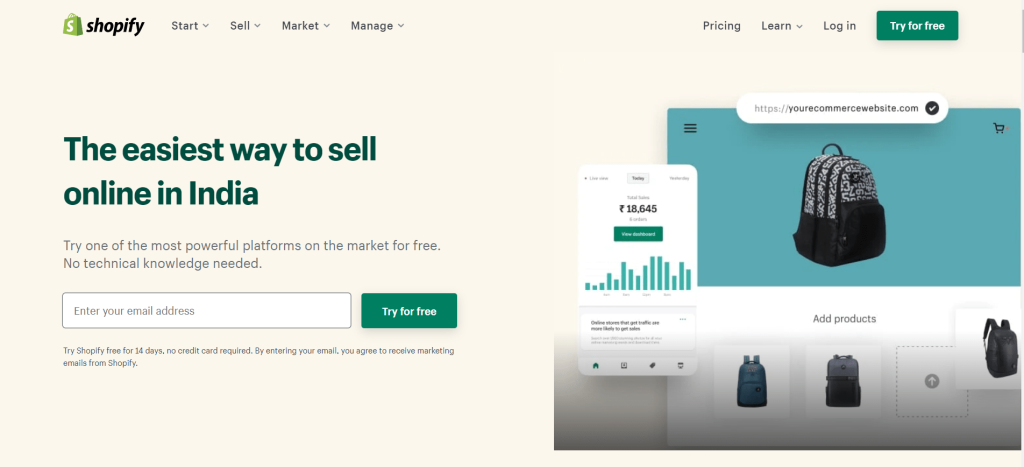
It’s a one-stop solution incorporating all e-commerce activities into a centralized platform. Simply put, it provides sellers with all the necessary tools to create ready-to-sell web stores, manage orders, and fulfillment, the payment collection facility, and so on. Moreover, you get marketing and advertising solutions to kick-start your business.
Based on your business requirements, you can get either of the Shopify plans:
Shopify Light
Shopify Light comes at $9/month and is more suitable for casual sellers. With light, you are not required to create a dedicated store for your items. Instead, you can use your existing social platforms (Facebook and WordPress), and Shopify will provide you with a fully integrated social media store on its website.
You can easily customize your social accounts from the Shopify dashboard by adding products, modifying descriptions, images, prices, etc.
Shopify Plus
If you stick to the Shopify business and have a long-term plan, then Shopify Plus is for you. Yes, it’s ridiculously expensive at $2000/month, but you get some exquisite tools and features to scale up your business quickly.
Additionally, you get a dedicated team focusing exclusively on your business needs 24/7. Other benefits include a Shopify Plus Academy, Merchant Success Training Program, 24/7 customer support, and more.
Why Should You Sell On Shopify?
Shopify eliminates the dreaded technical procedure of creating an online store by writing codes for hours. So, if you are a beginner with little to no technical knowledge, Shopify is the place for you. So here, you can get your store up and running within a few hours, and instead of writing hours of codes, you can focus on selling and marketing from the get-go.
Now, you must think – Why Shopify, not Amazon or eBay? Let me clear that out for you.
Shopify is a web-based e-commerce platform allowing you to create your store, list your products, and manage orders and payments. Amazon, on the other hand, is an online marketplace where you sell alongside other sellers.
While Amazon is a bigger organization, it needs more customization than Shopify offers. Also, the promotional tools are well-optimized on Shopify than on Amazon.
Therefore, you can see that it’s considerably easier to start with Shopify since you don’t need the capital and business experience that you might need at Amazon or eBay.
How To Sell On Shopify: A Step-By-Step Guide
You are set to start your Shopify store with all the information above. Now, let’s have a look at some key steps you need to take:
Registering At Shopify:
First of all, you need to register yourself on Shopify. To do that, go to the Shopify registration page, where you need to provide the following details
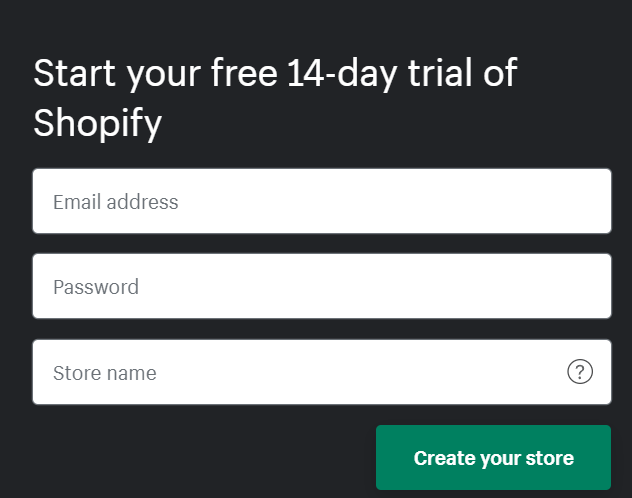
- A valid e-mail address for communication and identity purposes
- Preferred password
- Your store name
- Selecting a store plan:
Remember that your store name must be unique; otherwise, Shopify will not proceed to the next page. If you get a red warning signal, there is already a store with the same name. So be creative and come up with a catchy name for your shop.
Once you finish the initial registration process, you will be asked whether you are already selling, your business status, current revenue, etc. Pick your preferred option and answer the follow-up questions. Here are the questions you need to answer:
- Your current revenue
- Places you want to sell alongside Shopify
- The industry you want to sell items from
Of course, you can skip any page you don’t want to continue and move on to the next step, but I advise you to answer all the questions honestly, especially if you are starting your online business on Shopify for the first time.
Complete the final step in the registration process by providing your address details, including city, state, postal code, business website, and contact number. In addition, you will receive an email from Shopify to confirm your email address. Follow the instructions mentioned in the email.
Congratulations! You have successfully created your Shopify Store. Initially, you get a 14-day trial period, and it’s a good idea to get ahold of the platform, its features, and tools before you purchase a plan. However, if you fail to buy a premium plan after 14 days, you cannot access your store anymore, so it’s advisable to add products only after you feel ready to invest in a premium plan.
After confirming your email, you will be redirected to the Admin Panel of your store, where you can edit the following:
- Add products to sell
- Add/customize the theme of your Shopify store
- Purchase/Add a domain name
Let’s talk about the Domain name first.
Purchase A Domain Name:
A unique domain name gives your store an identity that will make it easily discoverable. Your buyers can directly find your store by typing your domain name the same as we type https://www.facebook.com/ to go to Facebook instead of finding it on Google every single time.
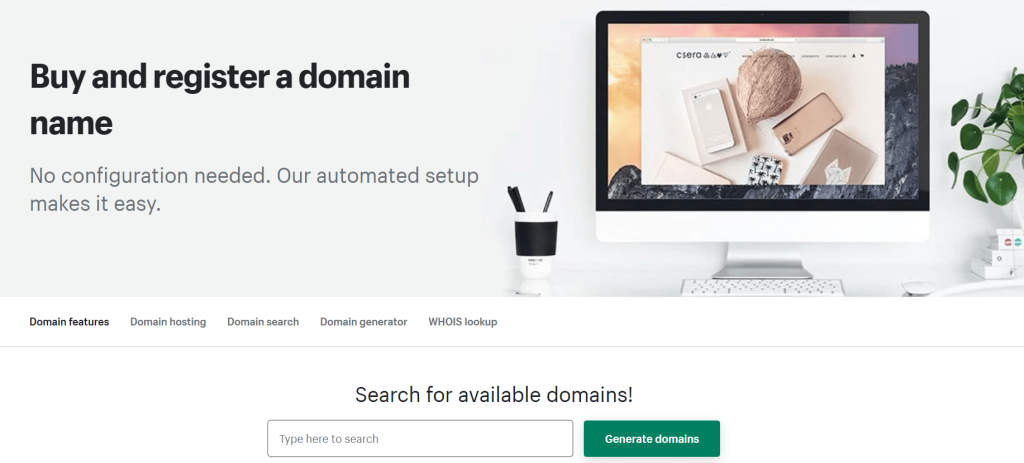
If you pay attention to the registration page, you are given a default domain name based on your chosen store name. You can keep the same domain if you want, but purchasing a domain that fits the criteria of a common domain name and is more relatable to the business category you will sell from is a good idea.
You can purchase a domain name directly at Shopify from several domain registrars. The pricing varies depending on the provider you choose and the type of name you choose, for example, .com, .net, .org, etc. The standard pricing of a domain name should be around $10-$20.
- Shopify Themes:
Shopify themes give your store a personal touch. Choosing an attractive theme with vibrant colors and engaging images is important to showcase your store as a professional and high-quality shopping spot.
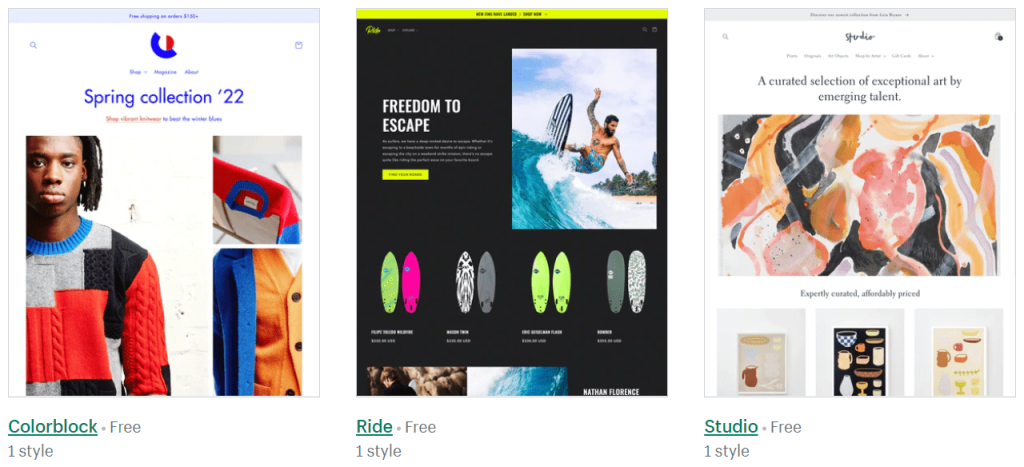
With Shopify, you can choose from free-of-cost pre-design theme templates or purchase premium ones at the Shopify themes store.
You can also design your themes using the customize option on the theme page. This allows you to use your product images, slide shows, and brand logo to give your store a more friendly look and feel.
- Adding the products:
Now, coming to the vital part of getting your store ready to sell. With millions of sellers trying to sell their items on Shopify, it’s not easy to initially find the sweet spot for your products.
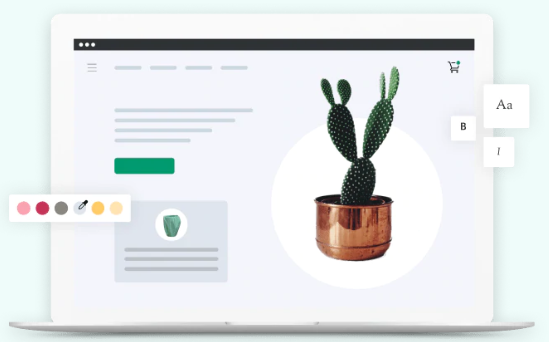
Make proper market research to find the winning products to sell that require a lower investment capital and can generate enough profit to survive the initial stage of your business.
You can find various market studies and video tutorials online exclusive to Shopify product research. This will give you valuable insight into choosing the right product and writing attractive product descriptions to attract more organic traffic to your page.
You can manually add the products if you have fewer items (five or fewer). Adding a product manually requires you to provide the following details:
- Product Title:
The name of your product should be on point, with just enough details to fit in the title box.
- Product Description:
In this section, you need to mention all the necessary information about the item, its features, functions, tasks it can perform, durability, and so on. Of course, the parameters can differ depending on the product type.
- Product Type:
Pick the product type and category from the drop-down menu. Stay as close as possible to the item category to have a higher chance of being discovered by customers.
- Vendor:
The manufacturer/vendor of the item you are selling.
- Availability:
List the places where the product is available, for example, social media sites, an offline store(if you have any), etc. Choose the online store if you are selling only on Shopify.
- Product Images:
You need to add the product images manually. Click on Add file to attach an image from your computer. Upload 5 or more high-quality images highlighting all the item’s physical aspects. You can also import the product image from a different website using the URL by clicking on Add Media from the URL.
Go to Add Product from your Admin panel and click on Add Product. Now there are several ways you can add a product to your listing.
However, you can upload products using a CSV file to save time if you own a big inventory with many items. Click on Import under the Products title and attach a CSV file to bring all the products to your store.
- Install the Supporting Apps:
Shopify allows you to install a bunch of productivity apps to improve the overall functionality of your store. You can browse the apps based on the categories such as store designing, marketing, customer support, inventory, product research, finances, advertising, and more.
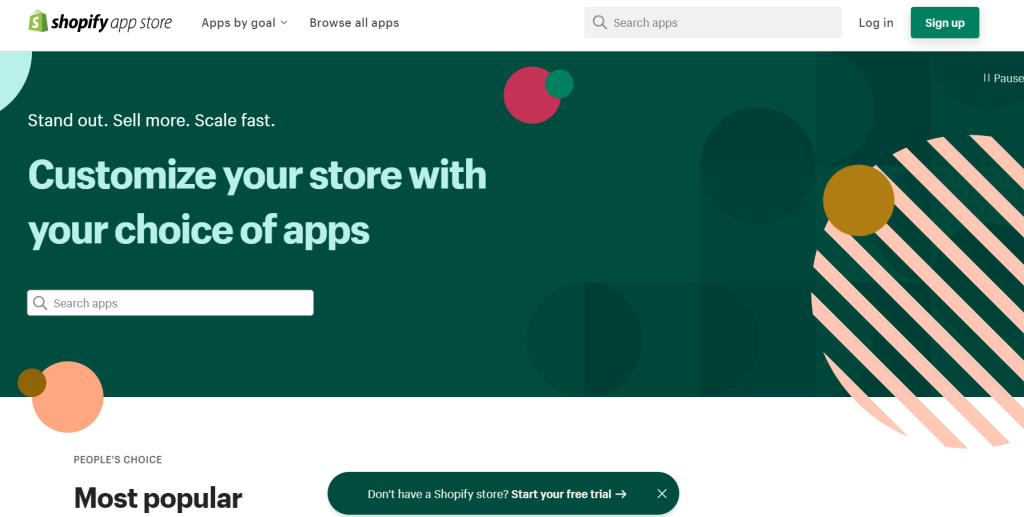
There are over 3500 free and paid apps on the Shopify app store. Here are my top picks:
- Google Shopping:
You can broadcast your products to interested customers across Google websites with Google Shopping. This helps generate traffic and advertise your products to a larger audience.
- Loox -Photo Reviews:
Loox allows you to collect product reviews with images. You can modify your items based on the reviews and highlight the positive reviews on your store to attract more buyers and strengthen your brand image on the platform.
- Shopify Email:
Shopify email lets you send personalized emails to your subscribers directly from the dashboard. In addition, you can add your store logo, product descriptions, and images in your email to market your new items to your existing customers.
- Advoz:
Advoz is a special media advertising app for your Shopify store. With this app, you can create customized adverts for social media platforms, including Facebook, Instagram, and Google, and broadcast your product to a large audience.
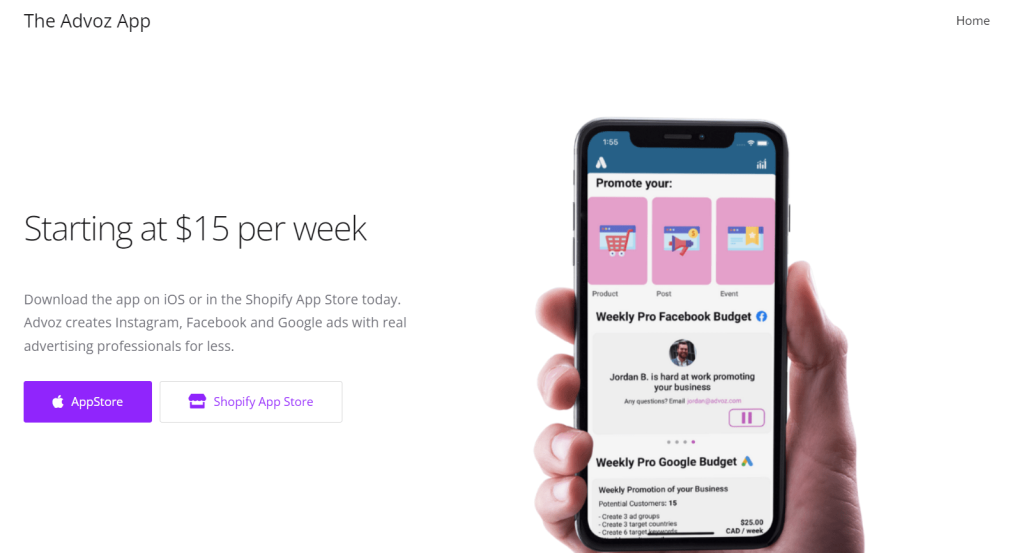
- Marketing and Advertising Your Products:
Online business is all about product research and advertising. No matter how good of a product you have in your store, until and unless you are discoverable on the giant internet platform, all your hard work and investment won’t have a fruitful outcome.
After listing your products, start allocating time and resources to advertising and marketing. Initially, your budget might restrict you from running paid Google or Facebook ads, but still, you can take certain steps to showcase your products in front of people.
- Social Media Campaigns:
For beginners, creating a dedicated social media page for your store is the best and most efficient way to market your product. You can even integrate your social media page into Shopify and create/modify product posts on your social media accounts (Facebook and WordPress).
For other social websites, you can create a page for your store, add posts with your product description and images, and try engaging with as many people as possible. You can hire social media influencers to market your products if your budget permits.
- Email Subscription:
Email marketing is one of the oldest marketing techniques since the invention of the internet. Create a few subscription forms on your store at the best possible location where they have a high chance of being noticed by the customers.
Once you have the subscriber, use the Shopify Email app to send them personalized product emails. There is no guarantee, but there is a high chance that the customer will eventually become a buyer.
- Video Adverts:
You can use product videos to broadcast on your store. Use the Promo app to create engaging and tempting product video promotions, giving customers a better sense of the product.
How to Promote and Grow Your Shopify Store?
To promote and grow your Shopify store, there are many strategies you can use. Utilizing social media platforms such as Instagram, Twitter, and Facebook to post about your products can help raise awareness of your store and get people interested in what you offer. You should also create content that is relevant to your target audience, such as blog posts or videos that feature product reviews or tutorials.
Additionally, discounts and promotions can greatly attract customers and encourage them to purchase from you. Finally, investing in paid advertising campaigns on search engines like Google and Bing will help put your store in front of potential customers looking for your products or services.
With these strategies implemented, you can quickly build a loyal customer base for your Shopify store.
Can You Close or Pause a Shopify Store?
Yes, it is possible to close or pause a Shopify store. This feature allows you to take a break from running your business without deleting all your products and customers. When you pause your store, all your product listings and customer data will remain intact. You can also access your account to make changes or update any information while the store is paused.
If you choose to close your store instead, this will completely shut down the shop and remove all products and customer data from the system. However, you can always reopen the store if you decide. This flexibility makes Shopify a great choice for entrepreneurs who want to take a break without losing their hard work.
Shopify: Key Features
Shopify is a powerful eCommerce platform with lots of features designed to help you run your business. Here are some key features that make it an attractive option:
- 24/7 customer support
- Online Store. E-commerce website and Blog
- Various sales channels, including Online marketplaces and Social Sites
- Manual order creation
- Customer filtering and grouping
- Free SSL certification
- Discount codes
- Email marketing
- Unlimited product listing
Shopify: Pricing Plans
Shopify has 3 premium plans – Basic, Shopify, and Advanced. Before going into details, here are the common features that you will get with every premium plan:
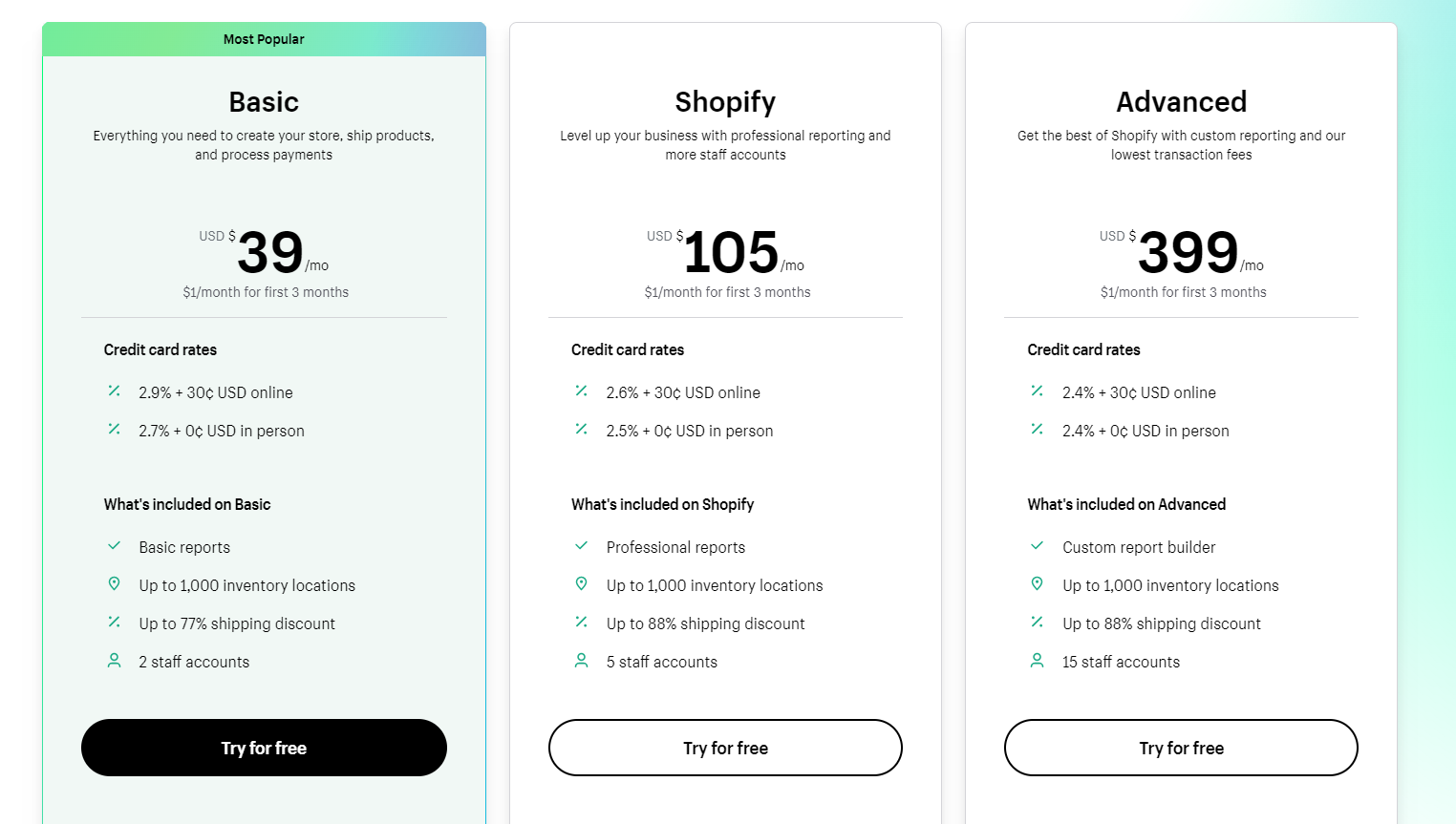
Basic
The basic plan is more suitable for newbies. It is a reasonable $39/month and provides 2 staff accounts. You can assign your inventory to up to 4 locations, including retail stores, warehouses, etc. With a basic account, Shopify charges you 2% as a transaction fee for every sale.
Shopify
Shopify is the most popular plan amongst all of them that will cost you $105/month. This plan is fit for medium-sized businesses that have consistent sales and are looking to expand their foothold. Here, 5 staff members can access the Shopify admin panel and POS compared to 2 in the basic plan. Also, you get 5 inventory locations to assign your inventory to. With a Shopify account, you pay a 1% transaction fee on each order.
Advanced
An advanced plan is designed for big enterprises with high-volume sales and is there to stay long-term. With the advanced plan, you get up to 8 inventory locations you can use to store your products. This plan is best for you if you have many employees, giving you 15 staff account access.
While it costs you $399/month, with the Advanced plan, there are additional benefits such as tax/duties estimation, manual task automation, calculated shipping rates, and advanced reporting. Moreover, you only pay a 0.5% transaction fee for each sale.
Related Read:
Final Words:
With Shopify, the opportunities are limitless. How far you can go depends entirely on your planning and implementation. But, as I mentioned, starting on Shopify is a piece of cake, but still, you need to understand the market, current product trends, and customers’ needs.
This basic selling guide will help you get going, but surely you will discover many new aspects of Shopify’s business over time.
Working out your business requirements, analyzing your budget, and understanding your products is necessary before you hit the ground. Don’t compromise the product quality, at least initially. A few positive reviews and your business will get the launch pad to mark its presence amongst millions of others.

This is Wagner, an experienced Amazon FBA expert, and eCommerce enthusiast. With years of experience selling on Amazon, I got a wealth of knowledge to share with fellow sellers. In their writing, I cover a range of topics including Amazon FBA strategies, eCommerce trends, and online retail best practices.
